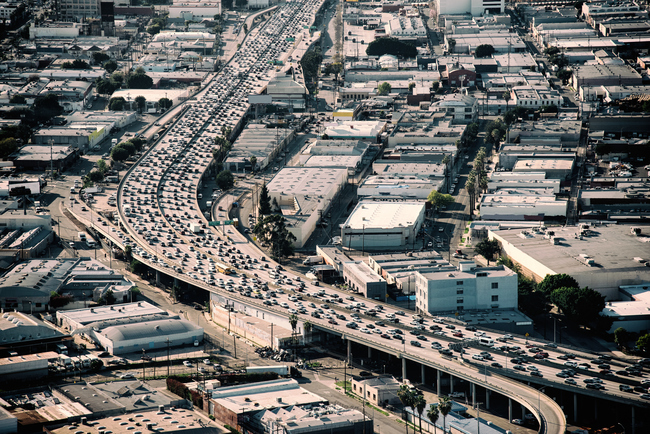Addressing Long Commute Times along the Slauson Corridor
In 2018, the city of Los Angeles received a grant to develop a neighborhood-level climate resiliency plan for South Los Angeles. Working with community-based organizations and the Los Angeles County Metropolitan Transportation Agency, the South Los Angeles Climate Commons Plan is intended to address climate change impacts and issues of environmental sustainability in conjunction with two large planning efforts in the area: the Slauson Corridor Transit Neighborhood Plan and Metro’s Rail-to-River Active Transportation Corridor project. In order to help inform responsive policy making in this geography, the South LA Climate Commons underwent a community engagement process to identify community priorities, one of which being the relationship between air quality, transportation and community health.
The Slauson Corridor
Home to just over 149,500 people, the Slauson Corridor makes up approximately 4% of the population in the City of Los Angeles. Predominantly Hispanic or Latino and home to a large immigrant population, the Corridor stretches across a number of Los Angeles’ historically Black neighborhoods and 19% of residents today identify as Black or African American. The population skews younger than the rest of LA County, with 41% under the age of 24 compared to the County average of 32%.
Educational attainment in the area is less than what is typical for Los Angeles County – approximately 7% of Slauson Corridor residents over the age of 25 have a Bachelor’s degree, compared to 32% of adults countywide. However, college enrollment in the neighborhood has been increasing and will likely continue to do so. According to 2018 data, 36% of Slauson Corridor residents between the ages of 18 and 24 are enrolled in school. This represents a significant increase from 2010, when just 21% of young people were enrolled in school.
Although the research on the displacement of low-income communities as a result of transit-oriented development is still emerging, a recent comprehensive literature review found a positive relationship between proximity to new transit developments and residential displacement. With a median household income of $36,544—significantly less than the LA County median income of $64,251— Slauson Corridor residents are particularly susceptible to the potential displacement pressures on low-income communities that can result from new public transit developments such as that of Metro’s. However, residents along the Slauson Corridor are also in need of improved transportation options.

Total carbon emissions from residents has increased significantly over time, resulting from declines in public transit use and rises in the number of workers driving alone and commuting out of the Corridor. According to 2017 CalEnviroScreen, the Slauson Corridor’s air quality is in the 90th percentile. This means that the particulate matter (PM2.5) concentration, a measure of particles that contribute to serious health problems, is higher than 90% of places in California. This not only demonstrates a need for interventions that curb greenhouse gas emissions in the area, but also address other impacts of increased car commutes amongst residents.
Health Impacts of Commuting

A recent report by the USC Sol Price Center for Social Innovation carried out to support the work of the South LA Climate Commons found that Corridor residents experience longer work commutes than the average worker in the County. As of 2018, 63% of workers living along the Slauson Corridor spend at least 30 minutes commuting to work, which is significantly higher than the countywide average of 51%. Further, the report found that the share of Slauson Corridor residents experiencing commutes longer than 30 minutes has increased 6% since 2010, in line with a similar increase across the County.
Public health experts have long agreed that our work commutes—the mode of travel, the duration, and the length—have important impacts for the quality of our daily lives and our long-term health. Increased work commutes impact community health through various spill-over effects that can influence overall mental and physical well-being of a population. Longer travel times mean less time spent with family and friends and is associated with reduced time spent in physically active leisure and social leisure. Further, research has shown that regularly commuting more than 30 minutes is associated with poor mental health outcomes. According to a study on the relationship between commuting and health outcomes in Sweden, long car commutes can lead to reduced physical activity; shorter sleep times; increased sick leave and absenteeism; lower reports of general well-being; and increased stress levels—all of which pose long-term health risks.
Opportunities to Reduce Commuting
The increases in commuting times in the Slauson Corridor largely stems from the growing number of workers in the area who travel to a job outside of the corridor. As of 2017 data, 96% of residents living in the Slauson Corridor were commuting to a job outside of the corridor, travelling an average distance of almost 13 miles to get to work. However, as a mixed-use neighborhood, the area hosts almost 18,000 jobs, with many of the top industries in the neighborhood being the same industries that employ Slauson Corridor residents. This suggests a possible synergy between the skillsets and knowledge of neighborhood residents and the skills required for jobs located in the neighborhood.

Given the corridor’s large concentration of residents under the age of 25, there are opportunities for engagement with young residents and local businesses that pair skills and training with local workforce needs. This creates an opportunity for proactive engagement with young residents and local businesses to create a new generation of residents who can both live and work in the neighborhood. Further, college enrollment in the area has increased significantly since 2010, expanding possibilities for additional workforce development programs in new and growing industries.
Conclusion
Given the corridor’s large concentration of residents under the age of 25, there are opportunities for engagement with young residents and local businesses that pair skills and training with local workforce needs. This creates an opportunity for proactive engagement with young residents and local businesses to create a new generation of residents who can both live and work in the neighborhood. Further, college enrollment in the area has increased significantly since 2010, expanding possibilities for additional workforce development programs in new and growing industries.

Mackenzie Goldberg
Mackenzie Goldberg is a Master of Urban Planning student at USC Price. She holds a bachelor’s degree in Religious Studies from Reed College in Portland, OR. Prior to coming to USC, Mackenzie worked as a writer and editor for an architectural publication based in Los Angeles, CA, where she came to understand the many ways in which policy undergirds our built environment. Her research interests lie at the cross-sector of planning policy, urban design, and community organizing. Through her work, she hopes to better engage communities in the systems that govern our cities.
Sources
Boarnet, M., Bostic, R., Rodnyansky, S., Santiago-Bartolomei, R., & Williams, D. (2018). Do Rail Transit Stations Induce Displacement? UC Davis: National Center for Sustainable Transportation. Retrieved from https://escholarship.org/uc/item/7j29d2g3
Hansson, E., Mattisson, K., Björk, J. et al. Relationship between commuting and health outcomes in a cross-sectional population survey in southern Sweden. BMC Public Health 11, 834 (2011). https://doi.org/10.1186/1471-2458-11-834
Kiron Chatterjee, Samuel Chng, Ben Clark, Adrian Davis, Jonas De Vos, Dick Ettema, Susan Handy, Adam Martin & Louise Reardon (2020) Commuting and wellbeing: a critical overview of the literature with implications for policy and future research,Transport Reviews, 40:1, 5-34. https://doi.org/10.1080/01441647.2019.1649317
Photo Attributions
Cover Photo: Photo courtesy of Istock/Tero Vesalainen
Photo 1: Photo courtesy of Istock/monkeybusinessimages
Photo 2: Photo courtesy of Istock/Art Wager
Photo 3: Photo courtesy of Istock/

